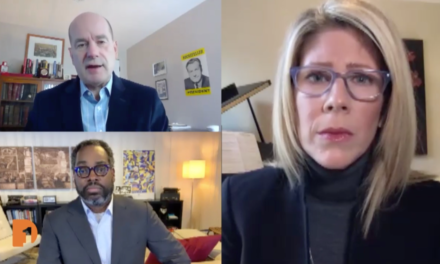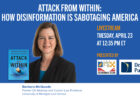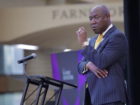For special education students, or kids who have IEPs (Individualized Education Programs), who learn in different ways and need certain supports, the new school year has been a tough transition.
During One Detroit’s Education Special: School Daze, the team took a look at how special education is being handled in districts, by getting a sense of teacher, parent, and administrative perspectives.
Watch the special >
And watch these clips covering special education needs below:
Pandemic prep: A special education teacher shows us her classroom
Livonia public schools students are learning virtually this fall, at least for now. That is, except for some of their special education students.
The district has started this fall with face-to-face teaching, just for those students who might find it more difficult to learn virtually.
One Detroit talked to middle school teacher Casey Loiselle, who shows us how she works with her students face-to-face in this virtual interview.
Read full transcript
Casey Loiselle, Special Education Teacher My name is Casey Loiselle, and I am a special education teacher for students with moderate cognitive impairments. And I am at Emerson Middle School in Livonia Public Schools. So right now, general education students are learning from home and the special education students had the option to come into the building face to face. So these are the desks in my classroom. And I have six students who come in the morning and I have four students who come in the afternoon. And the desks that we have are spaced out so that each student is able to sit socially distance from one another. I wear a mask and a shield while teaching, and for them to not see our faces and our smiles. That’s a lot of, you know, the positive part of school. So our amazing PTA actually made us these buttons with our faces on it. So students are able to see our smiles even though they can’t see them when they’re covered up by a mask. So students, although they’re only face to face in the building for two hours a day, they are provided with work to do at home. This is things through a Google classroom as well as a learning binder that Lavonia has decided to do this year, which has been a fantastic resource for families. I feel fortunate that our students had the option to come face to face. A lot of them receive occupational therapy, speech and language therapy, physical therapy, vision services that it’s very challenging to be taught through the computer.
Casey Loiselle, Special Education Teacher So while they are here for those two hours, it’s really great that they’re able to get those things and those direct services while they’re here at school.
Masking up and making Special education work during the pandemic
As schools roll into fall with safety procedures and virtual learning plans in place, One Detroit’s Nolan Finley finds out how special education teachers are handling the situation.
Finley talked to Rachel Fuerer who heads special education with the Eastern Upper Peninsula Intermediate School District was well as the Michigan Association of Intermediate School Administrators.
Fuerer said 80 percent of Michigan school districts are teaching face-to-face full-time or part-time.
Children in class, Fuerer said, aren’t having a problem keeping their masks on. “That’s and adult issue more so than a kid issue,” Fuerer said. “We have parents sending kids with the expectation that masks are going to be a part of everyday life.”
Read full transcript
Nolan Finley, DPTV Welcome to Rachel Fuerer, who is head of special education services for the Eastern Upper Peninsula Intermediate School District and also head of a statewide group that provides special education services to students.
Nolan Finley, DPTV I wanted you to talk to us giving your expertise about the special challenges that are faced in trying to provide an adequate education to special education students in this environment.
Rachel Fuerer, Special Education Director In my work with the Michigan Association of Intermediate School District Administrators, we’ve recently done a survey of our membership, and that’s all 56 intermediate school districts across the entire state of Michigan. We found that 80 percent of districts statewide are providing some face to face and hybrid instruction. So that’s a great start to the school year. We are happy to be back in classrooms with kids, whether that’s full time, which is almost 60 percent of our schools or in a hybrid part time Face-To-Face program. However, in in some places and primarily based on local health department regulations. So as part of the governor’s return to learn plan and the return to learn legislation, we’re required to work very closely with our health departments. So, you know, some local health departments are providing advice that it’s better to go slow and be safe. And so we’re certainly going to follow those regulations for for students that are face to face. What we’re finding as successes right now are, you know, everyone was worried about masks, masks, been in the news quite a bit. But what we’re finding that that’s an adult issue more so than a kid issue. Kids are really not having a problem with the mask. What that tells me that within our schools, the first couple days of school, we’ve done some really good instruction around masks. But even more importantly, we have parents who are sending kids with the expectation that masks are going to be a part of everyday life.
Nolan Finley, DPTV Well, that runs against conventional wisdom, doesn’t it? Rachel, I mean, going into this. The thought was, oh, you can never get kids to wear masks all day.
Rachel Fuerer, Special Education Director And the kids have been really, really amazing. And that’s across the board. We have membership from across the state and the social distancing is going well.
Rachel Fuerer, Special Education Director The sanitation –
Nolan Finley, DPTV Even for younger children?
Rachel Fuerer, Special Education Director Yeah, yeah. It’s been really remarkable.
Nolan Finley, DPTV So what what does that tell you about the ability to more broadly open schools?
Rachel Fuerer, Special Education Director Well, I think in in most cases and most districts, there should be a face to face option available. And that is the case in most schools and we’re continually working towards that.
Nolan Finley, DPTV And I’m assuming making the assumption that in many cases, special education students require a higher staff to student ratio just to deal with the challenges they face. How are you meeting the staffing requirements?
Rachel Fuerer, Special Education Director We’ve had a hard time retaining some of our our staff. Some folks, again, because of their own health status, are choosing not to come back. And we were already in a critical shortage of school personnel throughout the state. And so so it’s a real difficulty, I know, in our low incidents program. So programs for students with an autism spectrum disorder or cognitive impairment, for example, we run a three to one three students to one adult ratio for staffing. And it’s just really hard to find folks that are good enough to to come and work with our kids.
Nolan Finley, DPTV Beyond the doors, wearing a mask of social distancing. How are the students responding to the new education models? I mean, how are they the ones who particularly are staying at home and doing virt- learning online? How are they responding to this?
Rachel Fuerer, Special Education Director Well, students are all individuals and families are all unique. So it’s really across the board. We find that some students are really thriving and getting even more work done in that in that virtual environment. But in some cases, we’re having a hard time reaching families. We really want families to know that if you’re having difficulties with that virtual setting, we want you to reach out to us. We want to help problem solve in in some cases, actually, in many cases when schools are reaching out for the regular lessons or check in that they’re not getting a response at the scheduled time. And we’re really, really concerned. We want to be providing education to all of the children in our care.
Nolan Finley, DPTV So downstate, we know that there are some districts where petition participation is not nearly as high as as the districts had hoped. Detroit was out this week reporting that only 78 percent of their enrollment is participating in this new model of learning. What’s the participation rate in the Upper Peninsula in your districts?
Rachel Fuerer, Special Education Director So where we’re finding similar similar numbers in terms of students who have enrolled in virtual but are we’re having a hard time connecting with them. So we’re we’re finding similar difficulties across the state. And quite honestly, I think parents are really struggling at home. You know, for for many of us, we’re either finding alternate daycare and then expecting a daycare provider to support student learning in a home setting or a daycare setting or a parent is trying to balance working from home and supporting that student. It’s just a really difficult situation.
Nolan Finley, DPTV You are operating in an area where broadband and high speed Internet is not as common as it is, perhaps in other places of the state. How are you getting around that obstacle?
Rachel Fuerer, Special Education Director We we’ve set up community based hotspots where people can drive in. We’ve provided hot spots to homes. We live in the rural UP. And there are some spots, even with a hot spot provided by the district, that Internet just isn’t available. My home is one of them.Nolan Finley, DPTV What about the other services, schools in a rural area? Are you in an urban area with high poverty rates? Are the services they usually provide to support families, to support students? I’m thinking meals and afterschool programs, latchkey, etc.. How have you been able to maintain that level of support to your families and students?
Rachel Fuerer, Special Education Director Well, food service is something that has been maintained throughout since the beginning of the pandemic and throughout the whole summer. And an ongoing districts used busses and did home drop offs. And that level of support has really, really continued. And for most educators, it’s not just a job, it’s it’s a passion. And so we’ve been continuing to work throughout the summer and providing everything that we still can through throughout this whole period of time. I should mention, however, that just like everything else, the things that we do cost money and special education has been historically underfunded for many, many years. There have been several research studies done on that. And the latest numbers coming out of that 18, 19 school year were that special education in Michigan is underfunded by seven hundred and fifty million dollars a year. If you add the additional of responding to the pandemic on top of that shortfall, you can see that we’re gonna have a really hard time adequately resourcing what needs to happen right now.
Nolan Finley, DPTV Rachel Fuerer, director of special education for the Eastern Upper Peninsula Intermediate School District and head of special ed for IED throughout the state.
Nolan Finley, DPTV Thank you for joining us today on one. Enjoy.
Rachel Fuerer, Special Education Director Thanks so much, Nolan.
Special needs parents and the challenges of learning virtually from home
While so many Detroit area school districts have embraced virtual learning because of COVID-19, some students are not adjusting well to the change.
One Detroit hears from three families whose children have special needs.
Read the full transcript
Patricia Davis Hello, my name is Patricia Davis. I’m the mother of a seven-year-old little girl attending Ann Arbor Public Schools this year by virtual learning.
Eric McGrath I’m Eric McGrath, and I’m a parent of a child in Troy schools. His name is Gavin.
Kyra Montgomery My name is Kyra Montgomery. I have a son, Khyren Montgomery, who’s 13 years old. He has autism. He goes to Burger Baylor in Garden City Schools, and he is learning virtually.
Patricia Davis One of her diagnosis is emotional impairment.
Eric McGrath How do we know figure out how to move forward with a child with Gavin with dyslexia and these learning needs.
Kyra Montgomery We just got to a place where face to face was working out. Then, here comes COVID. And then a whole new learning process.
Patricia Davis It’s hard for the simple reason is–she has a support team. Now, when school was in session, she had a wonderful support team.
Eric McGrath One of the things that’s hardest for him is actually kind of sitting still.
Patricia Davis She’s from her bedroom with her Chromebook to the kitchen table with it to the living room with it back to her bedroom.
Kyra Montgomery For the last three days, Khyren has been sitting for fifteen minutes, which I call milestones.
Eric McGrath Actually, as part of his 504 plan, he’s allowed to sit on a sort of like an exercise ball and kind of bounce a little bit up and down.
Patricia Davis She was doing math online, and she just started getting very frustrated. She ended up kind of like having a meltdown.
Eric McGrath Some of the accommodations, you know, we can mimic at home, but some of them we can’t.
Kyra Montgomery I have to be there. And not only do I have to be there, I have to be present. And I have to be mentally present. I have to be there to coach him through.
Eric McGrath And I have to go to work. And, you know, your mom has to go to work.
And my and my older daughter, who’s 13, she’s she’s in the middle school and she doesn’t have any learning trouble at all. Although she can’t wait to go back to school and person, believe me.
Patricia Davis Actually, right now, no one in our public school district, to my knowledge, knows what is she is will be back face to face interaction in the class.
Kyra Montgomery And once we accomplish safety, then he can go back on campus. And truly, I’m not really hearing too much about when he’ll be going back to school.
Eric McGrath It looks like for choice schools as of yesterday, you could make a decision to have them go back or stay virtual. And it sounds like it’s going to be phased in over the next several weeks. On the one hand, you know, extremely nervous about his risk of catching COVID and other illnesses. But we don’t feel like we have another choice because for this learner, Gavin, the virtual it’s really not–not cutting it.








